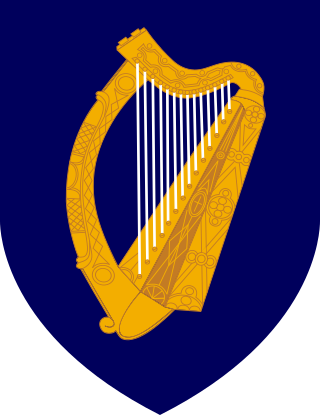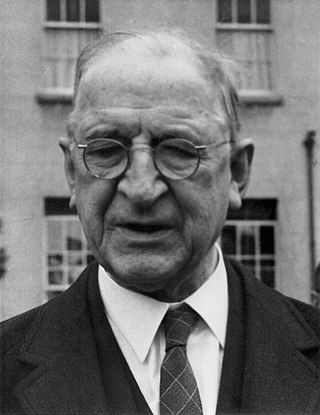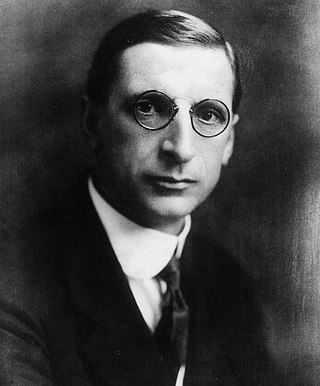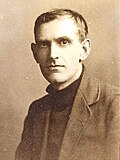
Ireland is a parliamentary, representative democratic republic and a member state of the European Union. While the head of state is the popularly elected President of Ireland, it is a largely ceremonial position, with real political power being vested in the Taoiseach, who is nominated by the Dáil and is the head of the government.

The 1938 Irish presidential election was the first Irish presidential election, held to fill the new office of President of Ireland.

The 1959 Irish presidential election was held on Wednesday, 17 June 1959. Éamon de Valera, then Taoiseach, was elected as president of Ireland. A referendum proposed by de Valera to replace the electoral system of proportional representation by means of the single transferable vote with first-past-the-post voting which was held on the same day was defeated by 48.2% to 51.8%.

The 1966 Irish presidential election was the fifth election in Ireland and was held on Wednesday, 1 June 1966. Incumbent president Éamon de Valera, 83 and with a rapidly deteriorating eyesight, standing for Fianna Fáil was narrowly re-elected, with Fine Gael candidate Tom O'Higgins coming within 1% of defeating de Valera.
The 1973 Irish presidential election was held on Wednesday, 30 May 1973. The outgoing president Éamon de Valera was ineligible for re-election after serving two terms in office. Former Tánaiste Erskine H. Childers, nominated by Fianna Fáil, was elected as president of Ireland, defeating Fine Gael deputy leader, Tom O'Higgins, who had come within 1% of defeating Éamon de Valera in the 1966 presidential election.
The 1976 Irish presidential election was precipitated by the resignation of President Cearbhall Ó Dálaigh in October 1976. Patrick Hillery was elected unopposed as the sixth president of Ireland.
There were two Governments of the 16th Dáil, which was elected at the general election held on 5 March 1957. The outgoing minority coalition government of Fine Gael, the Labour Party and Clann na Talmhan had failed to be returned. The 8th Government of Ireland was led by Éamon de Valera as Taoiseach, and the 9th Government of Ireland was led by Seán Lemass as Taoiseach. Both were single-party Fianna Fáil governments.
The Government of the 13th Dáil or the 5th Government of Ireland, formed after the general election held on 4 February 1948 — commonly known as the First Inter-Party Government — was an Irish government of Fine Gael, the Labour Party, Clann na Poblachta, Clann na Talmhan and the National Labour Party—and one TD who was an independent, James Dillon. The parties had many different aims and viewpoints, but opposition to Fianna Fáil overcame difficulties in forming a government; Éamon de Valera had led a series of single-party Fianna Fáil governments since 1932. The cabinet was made up of representatives of all parties, and ministers were given a great degree of independence. Some key events during the lifetime of the government include the declaration of the Republic of Ireland in 1948 and the crisis surrounding the Mother and Child Scheme in 1951.
The Government of the 15th Dáil or the 7th Government of Ireland was the government of Ireland formed after the general election held on 18 May 1954. Commonly known as the Second Inter-Party Government, it was a minority government of Fine Gael, the Labour Party and Clann na Talmhan. Clann na Poblachta, which had been in the First Inter-Party Government (1948–51) with these parties, supported the government but did form part of it.

The 1977 Irish general election to the 21st Dáil was held on Thursday, 16 June, following the dissolution of the 20th Dáil on 25 May by President Patrick Hillery on the request of Taoiseach Liam Cosgrave. The general election took place in 42 Dáil constituencies throughout Ireland for 148 seats in Dáil Éireann, the house of representatives of the Oireachtas, an increase of four seats with a significant revision of constituencies under the Electoral (Amendment) Act 1974. The election is regarded as a pivotal point in twentieth-century Irish politics. Jack Lynch led Fianna Fáil to a landslide election win, clearly defeating the outgoing Fine Gael–Labour government.

The 1973 Irish general election to the 20th Dáil was held on Wednesday, 28 February 1973, following the dissolution of the 19th Dáil on 5 February by President Éamon de Valera on the request of Taoiseach Jack Lynch. The general election took place in 42 Dáil constituencies throughout Ireland for 144 seats in Dáil Éireann, the house of representatives of the Oireachtas.

The 1957 Irish general election to the 16th Dáil was held on Tuesday, 5 March, following a dissolution of the 15th Dáil on 12 February by President Seán T. O'Kelly on the request of Taoiseach John A. Costello on 4 February. It was the longest election campaign in the history of the state, spanning 30 days. The general election took place in 40 Dáil constituencies throughout Ireland for 147 seats in Dáil Éireann, the house of representatives of the Oireachtas.

The 1954 Irish general election to elect the 15th Dáil was held on Tuesday, 18 May, following the dissolution of the 14th Dáil on 24 April by President Seán T. O'Kelly on the request of Taoiseach Éamon de Valera. The general election took place in 40 Dáil constituencies throughout Ireland for 147 seats in Dáil Éireann, the house of representatives of the Oireachtas.

The 1948 Irish general election to the 13th Dáil was held on Wednesday, 4 February following the dissolution of the 12th Dáil on 12 January 1948 by the President Seán T. O'Kelly on the request of Taoiseach Éamon de Valera. The general election took place in 40 constituencies throughout Ireland for 147 seats in Dáil Éireann, the house of representatives of the Oireachtas, with a revision of Dáil constituencies under the Electoral (Amendment) Act 1947, which had increased the number of seats by 9 since the previous election. The election resulted in Fianna Fáil leaving government for the first time in 16 years and the formation of the first coalition government in Ireland.
In Ireland, direct elections by universal suffrage are used for the President, the ceremonial head of state; for Dáil Éireann, the house of representatives of the Oireachtas or parliament; for the European Parliament; and for local government. All elections use proportional representation by means of the single transferable vote (PR-STV) in constituencies returning three or more members, except that the presidential election and by-elections use the single-winner analogue of STV, elsewhere called instant-runoff voting or the alternative vote. Members of Seanad Éireann, the second house of the Oireachtas, are partly nominated, partly indirectly elected, and partly elected by graduates of particular universities.
Events from the year 1945 in Ireland.
A vocational panel is any of five lists of candidates from which are elected a total of 43 of the 60 senators in Seanad Éireann, the upper house of the Oireachtas (parliament) of Ireland. Each panel corresponds to a grouping of "interests and services" of which candidates are required to have "knowledge and practical experience". The panels are nominated partly by Oireachtas members and partly by vocational organisations. From each panel, between five and eleven senators are elected indirectly, by Oireachtas members and local councillors, using the single transferable vote. The broad requirements are specified by Article 18 of the Constitution of Ireland and the implementation details by acts of the Oireachtas, principally the Seanad Electoral Act 1947, and associated statutory instruments.

Patrick McCartan was an Irish republican and politician. He served the First Dáil (1919–1921) on diplomatic missions to the United States and Soviet Russia. He returned to public life in 1948, serving in Seanad Éireann for Clann na Poblachta. McCartan was also a doctor.

The 2020 Irish general election took place on Saturday 8 February, to elect the 33rd Dáil, the lower house of Ireland's parliament. The election was called following the dissolution of the 32nd Dáil by the president, at the request of the Taoiseach, Leo Varadkar, on 14 January 2020. The members, Teachtaí Dála (TDs), were elected by single transferable vote in multi-seat constituencies. It was the first election since 1918 to be held on a weekend.

An indirect election for Seanad Éireann took place after the 2020 Irish general election, with postal ballots due on 30 and 31 March. The Seanad is the upper house of the Oireachtas, with Dáil Éireann as the lower house of representatives. The election was held for 49 of the 60 seats in the Seanad: 43 are elected for five vocational panels, and six are elected in two university constituencies. The remaining 11 senators are nominated by the newly elected Taoiseach when the Dáil reconvenes after the general election.













